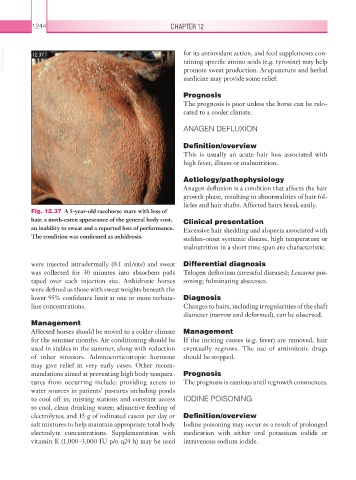Page 1269 - Equine Clinical Medicine, Surgery and Reproduction, 2nd Edition
P. 1269
1244 CHAPTER 12
VetBooks.ir 12.37 for its antioxidant action, and feed supplements con-
taining specific amino acids (e.g. tyrosine) may help
promote sweat production. Acupuncture and herbal
medicine may provide some relief.
Prognosis
The prognosis is poor unless the horse can be relo-
cated to a cooler climate.
ANAGEN DEFLUXION
Definition/overview
This is usually an acute hair loss associated with
high fever, illness or malnutrition.
Aetiology/pathophysiology
Anagen defluxion is a condition that affects the hair
growth phase, resulting in abnormalities of hair fol-
licles and hair shafts. Affected hairs break easily.
Fig. 12.37 A 5-year-old racehorse mare with loss of
hair, a moth-eaten appearance of the general body coat, Clinical presentation
an inability to sweat and a reported loss of performance. Excessive hair shedding and alopecia associated with
The condition was confirmed as anhidrosis. sudden-onset systemic disease, high temperature or
malnutrition in a short time span are characteristic.
were injected intradermally (0.1 ml/site) and sweat Differential diagnosis
was collected for 30 minutes into absorbent pads Telogen defluvium (stressful diseases); Leucaena poi-
taped over each injection site. Anhidrotic horses soning; fulminating abscesses.
were defined as those with sweat weights beneath the
lower 95% confidence limit at one or more terbuta- Diagnosis
line concentrations. Changes to hairs, including irregularities of the shaft
diameter (narrow and deformed), can be observed.
Management
Affected horses should be moved to a colder climate Management
for the summer months. Air conditioning should be If the inciting causes (e.g. fever) are removed, hair
used in stables in the summer, along with reduction eventually regrows. The use of antimitotic drugs
of other stressors. Adrenocorticotropic hormone should be stopped.
may give relief in very early cases. Other recom-
mendations aimed at preventing high body tempera- Prognosis
tures from occurring include: providing access to The prognosis is cautious until regrowth commences.
water sources in patients’ pastures including ponds
to cool off in; misting stations and constant access IODINE POISONING
to cool, clean drinking water; adjunctive feeding of
electrolytes; and 15 g of iodinated casein per day or Definition/overview
salt mixtures to help maintain appropriate total body Iodine poisoning may occur as a result of prolonged
electrolyte concentrations. Supplementation with medication with either oral potassium iodide or
vitamin E (1,000–3,000 IU p/o q24 h) may be used intravenous sodium iodide.

